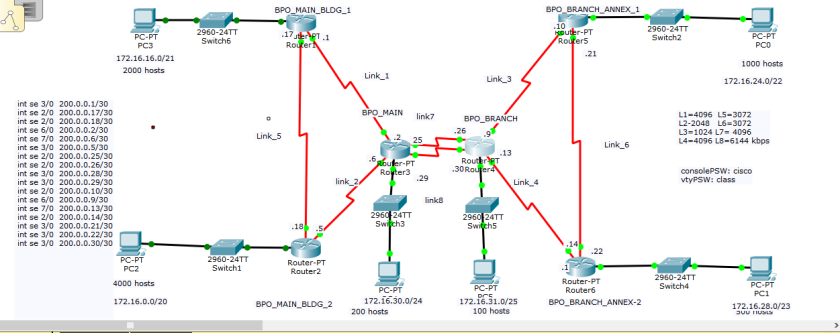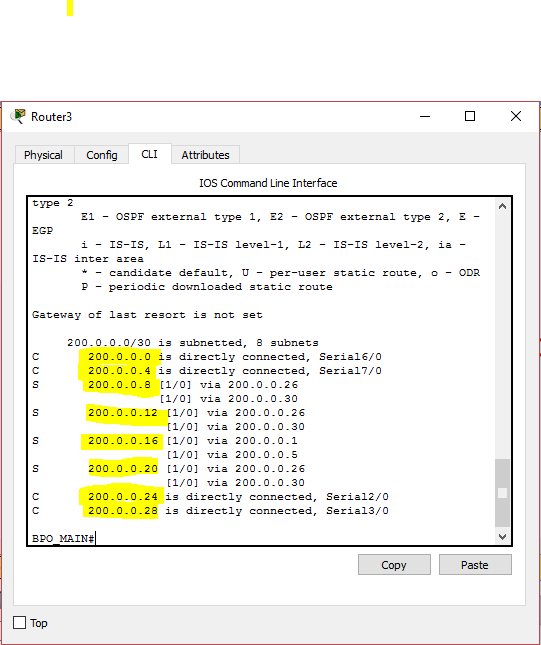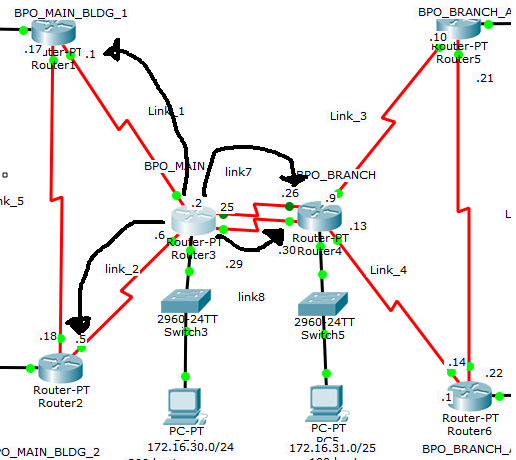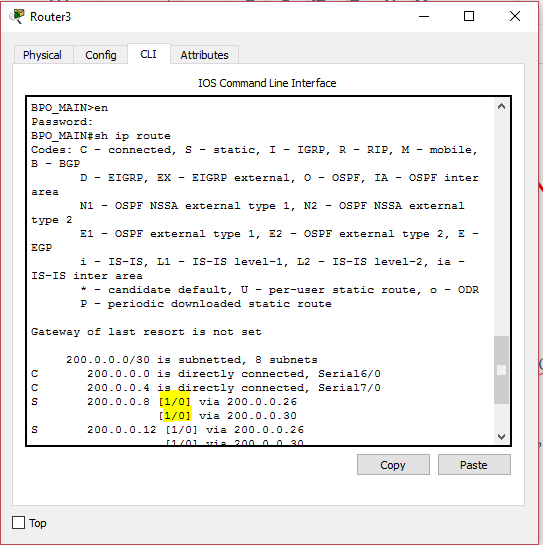3.2.a Prefix
3.2.b Network mask
3.2.c Next hop
3.2.d Routing protocol code
3.2.e Administrative distance
3.2.f Metric
3.2.g Gateway of last resort
Alright, so we are moving on interpretation of the components of routing table.
A.) Prefix- it refers to the network address that a router can see.
I got here a topology from the static routing topic.

and the routing table of BPO MAIN:

All the highlighted ip addresses are prefix. In IPv6 addressing, prefix is the term used to define network prefix.
B. Network Mask- Nothing complicated with the term ” network mask”. It is still subnet mask that you used to encounter. Subnet mask is actually an abbreviation to subnetwork mask which means the mask of a portion of network subnettted.

As you can see above, the network mask is highlighted which is 30 and it was subnetted to 8 subnetworks.
C. Next hop- The term next hop may refer to next hop router, next hop ip address or next hop interface.

The picture above is the best to illustrate next hop. Router 3 or BPO MAIN ‘s next hop routers are MAIN BLDG 2,MAIN BLDG 1, and BPO BRANCH
In BPO MAIN’s perspective, the next hop ip address are 200.0.0.5, 200.0.0.1 , 200.0.0.26 and 200.0.0.30
D.)Routing protocol code

The highlighted protocol codes above represent the most commonly used routing protocols. As you can see as well below, network prefix 200.0.0.8 is learned using static protocol by forwarding the packet to directly connected ip addreses 200.0.0.26 and 200.0.0.30.
E. Administrative distance
There are almost two decision reference for a router to determine what is the best path namely the administrative distance and the metric.

As you can see on the above image, on the prefix 200.0.0.8 –> [1/0] is the administrative distance and metric for static routing protocol.
The lower the administrative distance, the more the routers will believe that this is the best path
We can run multiple protocols in a network, so it is best to know that routers follow only the routing protocol listed on routing table with the lowest administrative distance.
Administrative is the reference for believability of the routing protocol.
Common Administrative Distance:
1.)Directly Connected Networks – 0
2.) Static – 1
3.) OSPF – 110
4.) RIP – 120
5.) EIGRP -90
6.) eBGP
Logically, router will follow static routing because we assigned it, we manually configured the routing but then again it is not advisable to large networks. Other dynamic routing protocols can be implemented and eBGP has the best admistrative distance.
F. Metric
Mate, what if I only used one routing protocol? how does a router will check the best routing selection?
Metric will be the reference if there is only one routing protocol.
Same theory applies, the lowest metric will have the best path.
Different routing protocols implement different routing metric. The following will be the metric of routing protocols:
RIP – hop
OSPF – costs
EIGRP – bandwidth + delay+ reliability+ load +MTU
BGP- attributes: weight, local preference, origin, AS path and multi exit descriminator
We will deal soon with those metrics once we hit the configuration as well.
G. Gateway of last resort

Gateway of last resort is the gateway we assigned on the router and serves as the path for LAN devices to be connected on the devices that pass through WAN links.
***************************END OF BLOG*********************************